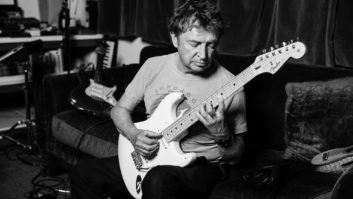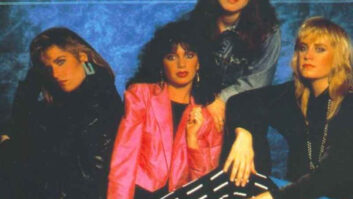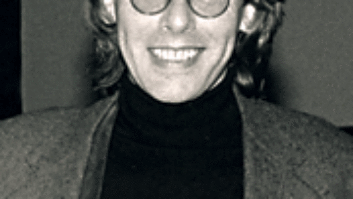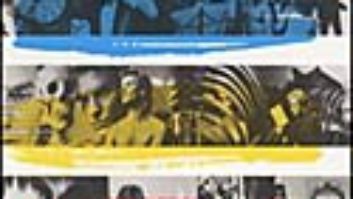Police drummer Stewart Copeland still can’t listen to Synchronicity without thinking of the last tough days he spent recording with The Police. The band had burst onto the scene with its unique sound — punk/new wave energy infused with ska and reggae— on Outlandos d’Amour in 1978, but as the band’s popularity grew, a power struggle within the trio ensued. While Copeland says the mood going into the 1983 release Synchronicity album was upbeat, there was trepidation, knowing that there would be battles fought with group leader Sting over creative direction.
“We could see the way the trend was going, and we knew the next album would be harder than the previous album,” Copeland says, referring to Sting’s growing control over the music. “It was, ‘Shall we try this idea?’ ‘No, we won’t. We’ll try this idea, and there will not be deviation from this idea.’ That was the origin of the argument, which turned into an atmosphere of anger and confrontation. I don’t hold anybody to blame for that point of view. That is a natural personality trait: To be self-contained and to have a full vision, artistically, of what you want to do. Mozart didn’t collaborate. There are many musicians who have a clear picture of what they want to say, particularly if they wrote the song and lyric. So, even though I had these big battles with Sting, I don’t hold them against him,” says Copeland, who says that he and Sting get together whenever Sting is in L.A. these days, but he doubts they could get to a place that would make it possible for a Police reunion tour (although they were scheduled to reunite for the Rock and Roll Hall of Fame show in the spring).
Copeland says that engineer/producer Hugh Padgham was ineffectual when it came to the creative battles, but “what he was good at was he knew where to put the microphone. He got a big sound. He got the ambient recording of the drums, but this is a perfect example of where putting the microphone in the right place clashed with making the band dynamic work: The big studio that George Martin built [AIR Montserrat, in the Caribbean] was at one end of the building, and I was upstairs in the old house in the dining room, all by myself with a television monitor connecting me to the studio downstairs across the way.
“The first thing you have to do when you record music is lay down a drum track, but we were making it up as we went along, and I wasn’t in the room with them. So, instead of finishing playing and going, ‘Hey, that was good there, and that went there,’ there is silence. I can’t hear what one of them is saying unless one of them presses the talk-back button. They aren’t pressing the talk-back button, but I can see that they are talking and I assume it’s bad. The drums sounded incredible because that was definitely the place to get the best sound out of the drums. Inarguably, the drums sounded brilliant in that room.”
Padgham, who also produced Ghost in the Machine with the band, says that he felt his hands were tied when it came to dealing with the personal dynamics within the band: “It was difficult for me to do anything about the fighting, because when I would try to say something like, ‘Come on guys, do you have to kick the shit out of each other?’ they would say, ‘You don’t know anything about us.’ Relative to their being a band, I knew them for a very short space of time, and their attitude was, ‘You can’t tell us what to do. Stay out of it.’”
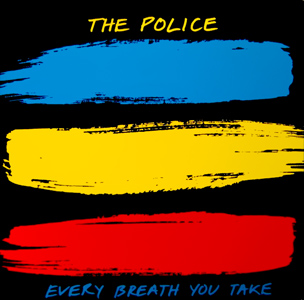 Copeland says that AIR Studios was an appealing place to record the album because it was a long flight from the nearest record company. He recalls that during the making of their third album, ZenyattaMondatta, executives were constantly present, “looking for the hit” since the band’s profile had grown so. The Montserratretreat was also better for the band because, “The closer the confines, the better we got along. The minute there was a life outside the group, the group just seemed like the place you didn’t want to go back to.”
Copeland says that AIR Studios was an appealing place to record the album because it was a long flight from the nearest record company. He recalls that during the making of their third album, ZenyattaMondatta, executives were constantly present, “looking for the hit” since the band’s profile had grown so. The Montserratretreat was also better for the band because, “The closer the confines, the better we got along. The minute there was a life outside the group, the group just seemed like the place you didn’t want to go back to.”
Copeland says that he knew instantly upon hearing “EveryBreath You Take” that it was The Big One. “The demo was Sting singing over a Hammond organ, which was rare at that time, because by then, we all had home studios, so we’d show up with these fully mastered demos. In the case of ‘Every Breath,’ what he brought to the band was much more simple, so we did a lot to it, as we did in the early days. We threw out the Hammond Organ part completely, since we don’t have an organist in the group, but we do have a great guitarist [Andy Summers] who would be underutilized in such an important song. Andy went away and worked out that guitar part, and suddenly it all made sense. We knew it was a big song, but it sounded too pedestrian, in spite of the great lyric, and it wasn’t until Andy came up with the guitar part that it clicked in.”
When recording the guitar, Summers was in the studio with what would now be a very unfashionable guitar amplifier, Padgham says. “It was a Roland JC-120, which was a solid-state guitar amp. It had a chorus sound: A slightly out-of-tune sound that had just been invented in the early ’80s. It had two 12-inch speakers in it, and you’d get a straight signal out of one speaker and then the second speaker would be slightly out-of-tune, and the tuning would vary up and down. If you miked both speakers very closely with an SM57, and then rooted each mic to the left and the right of your stereo speaker, you got a really wide stereo sound. We thought that was pretty hip in those days. And sometimes we’d double-track it, as well, where we’d have the straight sound on the left, the chorus sound on the right and then double-track it with the straight sound on the right and the chorus sound on the left, so you got this really thick, wide sound. Everything went through either that, or he also had a Fender Twin Reverb for straight, sharp, proper sort of guitar sounds.
“A lot of the synthesizer parts on the Police records were played through a guitar synth that Andy would play,” Padgham continues. “It was a Roland guitar synth with a pick-up either put on one of his guitars or they actually made their own guitar with a pickup on it. Roland made two guitar synthesizers in those days— one was blue and one was yellow — and Andy would split the guitar signal: Come out of the guitar, go into a Y splitter into the blue synth and into the yellow synth, and they would, in turn, both feed their own Marshall amplifier with a 4×12 cab turned up very loud. Then we’d mike the cabinet, so we got a subtly different sound coming out of each Marshall, again one going to the left speaker and one going to the right. So a lot of those swelly synth sounds would be his guitar amp, although we did have a Prophet synthesizer and some Oberheim synthesizers, as well.”
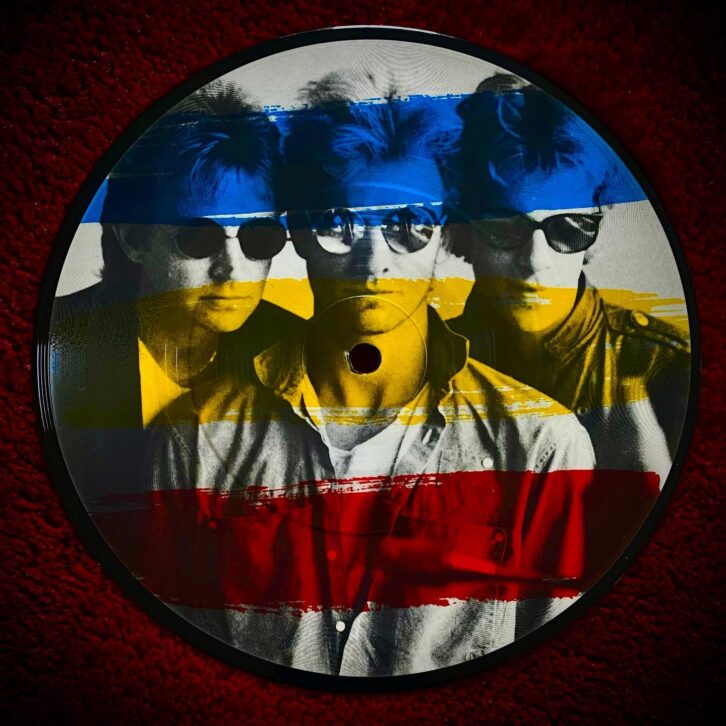
Unlike the other tracks on the album, which Copeland says generally took a day, “Every Breath” took a week because of the simplicity of the song. “We couldn’t do a lot of stuff because that would ruin it, so the stuff we did had to be the right stuff. We tried this, we tried that, such as a reggae version, which didn’t seem important enough. We tried a more rock track and I can’t even remember most of it because it was so unmemorable.
“When Andy came up with that guitar part, I felt personally that I didn’t have to come up with one of those interesting rhythm turn-arounds, like in ‘Can’t Stand Losing You’ or‘Roxanne,’ because it seemed like the guitar part was the trick. So we had the song and we had the trick, and all we had to do was make your foot tap to it. The drum part is very simple: The kickdrum is from a drum box — an Oberheim — and I overdubbed the snare drum, which is actually a snare drum and a Tama gong drum played together, one in one hand, one in the other so you get a really heavy, but cracking, backbeat. Then the hi-hat was overdubbed as a separate track. For the swooshes into the choruses, I overdubbed the gong drum with a cymbal swell played with soft mallets. The drum part was completely assembled with overdubs.
“The drums were miked with BBC ribbon mics — Coles 4038s— on the overheads on the cymbals,” Padgham adds.“Those have become very popular now in America but weren’t then yet. Then we used the normal Shure SM57 on the snare drum, which was only miked from the top. We used Sennheiser 421s on the tom-toms and I believe a Neumann U47 on the kick drum, and part of the sound was the room mics. Stewart was in a dining room with a wooden floor, which was much more reflective than the studio, which was quite deadened, having been designed in the mid-’70s. We used Neumann 87s about 10 or 15 feet away from the drums. Quite often, we had Stewart’s hi-hat digital delay line, which gave it that hi-hat sound that drummers have tried to emulate but can’t. I recently told a drummer who was mortified that there was a 300-millisecond delay on the hi-hat, so there was no way that even Stewart played it, because the polyrhythm came from the delay time.” Padgham notes that Copeland took the Korg digital delay line with him on the road to reproduce the effect live.
Padgham also recalls having to gaffer-tape the sticks to Copeland’shands and the headphones onto Copeland’s head because of the heat in the area. “Stewart would get quite sweaty,” he says.“He would get three-quarters of the way through a take and the sticks would go flying out of his hands. Obviously, we could physically slice the tape with a razor blade, but it wasn’t like today with ProTools, where it’s incredibly easy to do all that sort of thing.”
Copeland says “Every Breath” was the most pieced-together of all the songs on the album. “Every other track, we played the track and either cut it up or overdubbed to it or dropped stuff out of it. I think this is the only one where we didn’t play the track. We laid down a rhythm box, did an overdub, added some more rhythm, then did another overdub and built it piece by piece rather than playing it. It’s a much more complex track than it sounds. There’s the piano solo, which Sting played, and the [guitar] power chords in the chorus — 20 tracks of those. When Sting got into the vocals, there were another three days of getting every syllable right.”
Classic Tracks: Big Star’s “September Gurls”
Padgham says that he always had a problem finding the right mic for Sting’s vocals. “He’s got quite a dull tone to his voice,” he says. “I think on Synchronicity, we used an AKG 414mic, which was quite a sort of ‘toppy’ mic. It might have been a Neumann U47. I think we did a lot of the vocals in the control room. We probably went through a UREI 1176 compressor, which was, and still is, my favorite for vocals.”
Recording the bass could be frustrating, Padgham says, when Sting wanted to play while jumping on a mini trampoline. “It sounds mad—and I have trouble recalling whether it was during Ghost in the Machine or Synchronicity, because we recorded them 18 months apart at the same place 20 years ago — but what was really annoying was, even at the best of times, with all due respect to Sting, who is a fantastic bass player, he’s quite sloppy. If you solo his bass track, there’s all sorts of fret noise and bits of dodgy playing. When he was bouncing on the trampoline, it made it even worse. But, of course, if you said, ‘Could you not bounce quite so much, please,’ he’d bounce even more. Nowadays, I’d know to say, ‘Could you bounce more please,’ and he’d probably get off it! With respect to his sound, whether he was bouncing on the trampoline or not, he always used his old Fender jazz bass, and it was never put through an amplifier. I only ever DI’d it, and in those days, it always had a bit of Boss chorus pedal on it, which made the bass sound a little thicker. Then we would overdub a Dutch upright electric double bass that was nicknamed Brian. It was, ‘Let’s put Brian on the track.’ He wouldn’t emulate the whole part, just perhaps the first note of the bar.”
Padgham says that the outboard effects were minimal: “In those days, there weren’t 4 million digital reverbs. We recorded on an old Neve console, so it was all recorded through those lovely, old, Class-Amic pre’s, and recorded onto MCI 2-inch machines. I’m pretty sure we used 30 ips, and we might even have used Dolby on some tracks, as well. I had an obsession about tape noise at the time, and on some of the quieter Police tracks, I was worried that people would accuse me of being a bad engineer if there was any noise,” says Padgham, who adds that his assistant engineer on Synchronicity was Renata, who ended up marrying Elton John. “I think the whole album was done on 24-track analog, which most albums were then, and you’d never think of attempting that now with loads of harmonies going on,” says Padgham, adding that they mixed the album in Canada on an SSL.
It’s hard to believe that this album, which still holds up so well two decades later, nearly never got recorded. Ten days into the recording, they had nothing tracked, which prompted an executive crisis pow-wow. Manager Miles Copeland flew in to meet with Padgham and the band, and they had to decide if they could buckle down to get the album done or quit right then. “That album was perhaps one meeting away from not happening,” Padgham says. “I remember right before that, ringing up my manager and saying, ‘I hate this,’ because sometimes the tension in the room was so horrible. But in many ways, that tension is what ended up making such a good album.”
